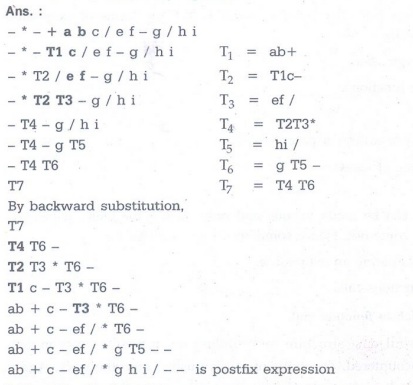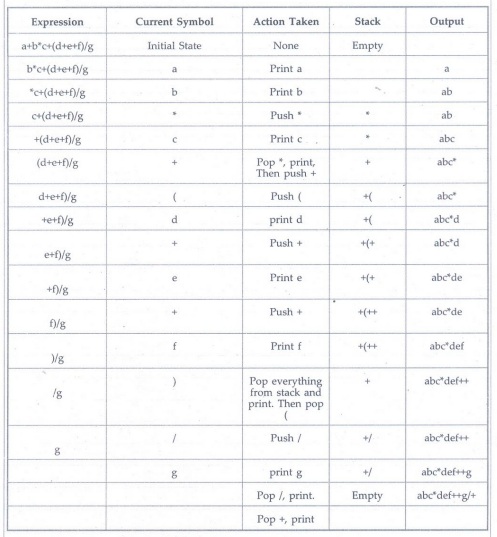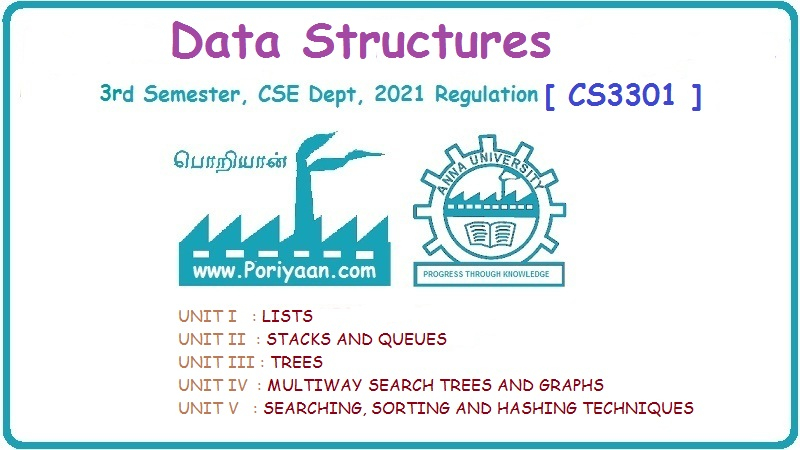Data Structure: Unit II (a): Stacks
Two marks Questions with Answers
Stacks | ADT Data Structure
In computer system the memory model consists of stack memory stores types of variables that have a fixed lifetime based on how C programs run.
Two Marks Questions with Answers
Q.1 Give an example that shows how a stack is used by a computer system.
Ans. : In computer system the
memory model consists of stack memory stores types of variables that have a
fixed lifetime based on how C programs run. It is a section of RAM that grows
and shrinks as the program runs. When you call a function, its parameters and
any variables you have defined in that function (which are not static) are
stored on the stack.
Q.2 What do you understand by polish notation?
Explain.
Ans. This is also called as
prefix notation. In this type of notation the operator followed by two
operands. For example if (a+b)*c is a given expression then its polish notation
will be *+ abc.
Q.3 What is a top pointer of a stack ?
Ans. The top denotes the only
one end of the stack from which the element can be inserted or deleted. When we
push the element onto the stack, the top is incremented. When we pop the
element from the stack the top is decremented.
Q.4 Write the postfix notation for following expression.
(A+B)*C-(D-E)^F
Ans. Following steps can be
followed for computing the postfix expression -
Step 1:
(AB+)*C-(D-E)^F
Step 2:
(AB+C*)-(D-E)^F
Step 3:
(AB+C*)-(DE-)^F
Step 4:
(AB+C*)-(DE-F^)
Step 5:
AB+C*DE-F^-
Q.5 Write any two applications of stack.
Ans. : The stack can be used for
-
1.
Conversion of expression from one form to another. Various forms of expression
are infix, prefix and postfix.
2.
Evaluation of postfix expression.
3.
Evaluation of recursive functions.
4.
Reversing the string.
5. For
checking the well formedness of parenthesis.
Q.6 List the characteristics of stacks.
Ans;
1.
Insertion and deletion can be made by one end only. Hence the element inserted
last will be first one to come out. Hence sometimes it is called LIFO.
2.
Stacks are useful for evaluating an expression.
3.
Stacks can store the functions calls.
Q.7 Write the role of stack in function call.
Ans. : The stack is an useful
data structure for handling the recursive function calls. When a recursive call
is encountered, the status of call is pushed onto the stack. And at the return
of the call the stack is popped off. Thus execution of recursive statements is
done with the help of stack.
Q.8 What is Last-In-First-Out strategy? Which
data structure follows this strategy?
Ans.
: In the Last In First Out strategy we insert the element in the data structure
lastly and while removing the elements from this data structure, the element
which is inserted lastly will get removed first.
The
stack data structure makes use of Last In First Out(LIFO) data structure.
Q.9 Write the steps to reverse the contents of
the list with the help of stack data structure.
Ans
Step 1: Read each element from
the list and push it onto the stack.
Step 2: Pop the element from the
stack and store the popped element in a separate array.
Step 3: Read the array completely
from left to write. This will be the reversed list of the elements.
Q.10 Which data structure is used in handling
the recursive function ? Ans. : The stack is used to handle the
recursive function call.
Q.11 Given the prefix for an expression write
its postfix. -*- +abc/ef-g/hi
Ans. :

Q.12 Give the infix for an expression, write
its prefix a* b/c + d?
Ans.
: The prefix expression is /* ab + cd.
Q.13 Convert the following infix expression to
postfix expression using Stack.
Ans. :

The
required postfix expression is abc*def++g/+.
Q.14 State the rules to be followed during
infix to postfix conversion.
Ans. :
Algorithm
Read an
expression from left to right each character one by one
1. If an
operand is encountered then add it to postfix array.
2. If
'(' is read, then simply push it onto the stack. Because the (has highest
priority when read as an input.
3. If
')' is reads, then pop all the operands until (is read. Discard (. Store the
popped characters in the postfix array.
4. If
operator is read then
i) If
instack operator has greatest precedence (or equal to) over the incoming
operator then pop the operator and add it to postfix expression. Repeat this
step until we get the instack operator of higher priority than the current
incoming operator. Finally push the incoming operator onto the stack.
ii) Else push the operator.
5. The
postfix expression in in array.
Data Structure: Unit II (a): Stacks : Tag: : Stacks | ADT Data Structure - Two marks Questions with Answers
Related Topics
Related Subjects
Data Structure
CS3301 3rd Semester CSE Dept | 2021 Regulation | 3rd Semester CSE Dept 2021 Regulation
